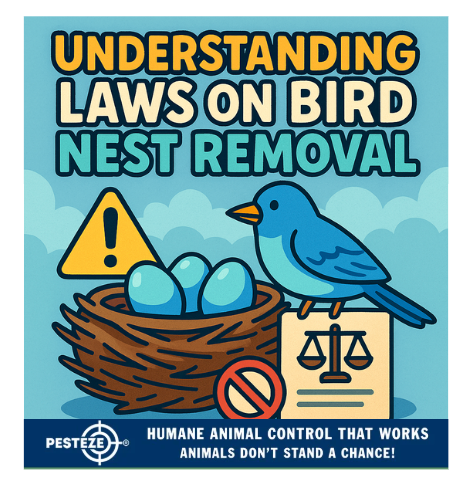UNDERSTANDING LAWS ON BIRD NEST REMOVAL

UNDERSTANDING LAWS ON BIRD NEST REMOVAL
SUMMARY
Bird nests can cause challenges when found in homes or businesses, but removing them is not always legal. This guide explains bird nest protection laws, when removal is allowed, and how to handle nests responsibly.
FEATURES
-
Legal protections: Many bird species are protected by law.
-
Timing matters: Removing active nests with eggs or chicks is often illegal.
-
Permits required: Special cases may need wildlife permits.
-
Safe alternatives: Wait until nesting season ends before removal.
-
Professional help: Licensed experts ensure compliance and safety.
-
Prevent future nesting: Use deterrents and barriers after removal.
GUIDE DESCRIPTION
Birds frequently build nests in attics, vents, chimneys, or rooftops, where they may cause inconvenience or damage. However, before removing a nest, it’s crucial to understand the laws that protect birds and their habitats. Mishandling nest removal can result not only in harm to wildlife but also in significant fines.
In many countries, including the United States, bird nest protections are established by law. The Migratory Bird Treaty Act (MBTA), for example, makes it illegal to harm or remove the nests of most native bird species while they are active. Similar laws exist worldwide, aimed at conserving bird populations and protecting biodiversity.
The key factor is whether a nest is active or inactive. An active nest contains eggs or chicks and is being used by birds. These nests are almost always protected, meaning removal is prohibited until after the young birds have fledged. Inactive nests, once abandoned, may often be removed legally, though it’s still important to check local regulations.
In some cases, permits may be required. If a nest is causing health hazards, blocking ventilation, or creating dangerous conditions, wildlife agencies may issue special permission for removal. Such permits must usually be obtained before taking action.
If immediate removal isn’t allowed, there are safe alternatives. Waiting until nesting season ends is often the most practical and lawful option. Once the birds leave, the nest can be removed, and preventive measures can be put in place.
For homeowners or businesses unsure of how to proceed, seeking professional help is recommended. Licensed wildlife control specialists or rehabilitators understand the laws and can carry out nest removal safely and legally.
After removal, take steps to prevent future nesting. Installing vent covers, mesh screens, or deterrents like reflective tape can discourage birds from returning. Regular inspections also help ensure nests don’t reappear in problem areas.
By understanding the laws on bird nest removal, you can handle the situation responsibly, ensuring both legal compliance and humane treatment of wildlife.
- Saneeth Thota


Comments 0